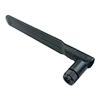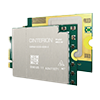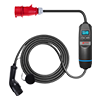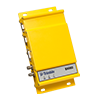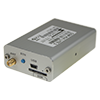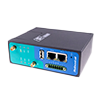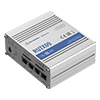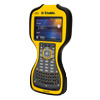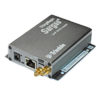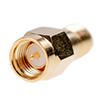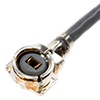Did you come across a word on our site that you did not understand? For better comprehension, we have prepared a Glossary for you, where you will find an explanation of all basic and lesser-known terms and their brief explanation in the field of antenna technology, wireless modules, routers, M2M and IoT technologies, electromobility, RFID.
Glossary
3G Technology
PoE
PoE (Power over Ethernet) is a technology that allows electronic devices to be powered via a standard Ethernet cable, which otherwise transmits only data. Thanks to PoE, there is no need to install a separate power cable for the device, which simplifies and reduces the cost of installation—for example, for IP cameras, WiFi access points, VoIP phones, or IoT devices.
The Ethernet cable can thus transmit both data and electrical power simultaneously. The main advantages of PoE include flexibility, easier installation, safety, and the ability to provide centralized power or remote device reboot.
Zigbee Technology
Zigbee is a wireless communication technology designed for low-power, short-range networks, commonly used in IoT (Internet of Things), smart homes, industrial automation, and monitoring. It typically operates on the 2.4 GHz frequency, offers a data transfer rate of up to 250 kbps, has a range of about 10–100 meters, and supports mesh network topology, which enables reliable communication between devices with very low power consumption.
4
4G technology
4G is the fourth generation of mobile telecommunication technologies, offering very fast data transfer and reliable voice services. In the Czech Republic, the most commonly used frequency bands are 700 MHz, 800 MHz, 1800 MHz, 2100 MHz, and 2600 MHz. The 4G network is commonly known as LTE (Long Term Evolution), although it does not fully meet the original 4G specifications. The 4G version already includes some support for 5G networks. Mobile networks in many countries still rely on 4G technology, which will continue to play an important role for years to come.
5
5G technology
5G technology will gradually replace or expand today's very popular LTE networks. It is characterized by a higher baud rate and a; significant reduction in response time. 5G antennas are used in M2M, IoT devices and IoT systems. 5G technology also enables the development of new applications in areas such as virtual and augmented reality, autonomous vehicles and industrial automation.
A
A current rating of 12 A, 16 A, or 32 A
A current rating determines how quickly the charger can deliver power to the battery.
A plug-in hybrid
A Plug-in Hybrid is a car that combines an internal combustion engine with a battery that is charged from a socket. A Plug-in Hybrid must be plugged into a socket to use its full electrical capacity.
A residual current device (RCD)
A residual current device (RCD) is safety component that disconnects the circuit when leakage current is detected, preventing electric shock.
AC charging technology
Electric vehicle charging is done using either alternating current (AC) or direct current (DC), each with its pros and cons. AC Charging is slower and typically used at home or work. DC Charging (fast charging) is quicker and usually found at public charging stations.
AC Charging is standard charging, used at home, work, or public locations with slower charging. The AC from the power grid is converted into DC in the car’s onboard charger and then stored in the battery. Charging usually takes several hours. Advantages include affordability and suitability for overnight charging.
Access Point
An Access Point (AP) is a device that allows smartphones, tablets, smart TVs, and other devices to connect to a wireless Wi-Fi network. It converts data from a wired network into wireless transmission, providing Wi-Fi coverage in a specific area. Users connect through the access point rather than directly to each other. It's commonly used to expand and improve Wi-Fi coverage, particularly in large spaces or public buildings.
Active antenna
Active antenna includes an integrated amplifier that amplifies the signal level. Active antennas can be used for both reception and transmission and need to be powered. Nominal power values are around 2.2-5 V. GNSS antennas are a common example of active antennas.
Antenna attachment methods
We offer a wide range of antennas with various mounting methods: adhesive, mounting, screw, magnetic and soldering.
Antenna efficiency
The efficiency of the antenna is expressed as the ratio of the power radiated by the antenna Pv to the delivered power Pz. The resulting value is then given in %.
Attenuation
Attenuation (loss) is a decrease in signal strength. It is given in decibels (dB). Attenuation is undesirable, it is often caused by mismatch of the RF transmission system. These losses can be caused by impedance, polarization mismatch or it can also be inserted attenuation eg on coaxial cable (which increases in proportion to cable length), connectors and splitters.
B
Battery capacity (Ah)
Battery capacity indicates how much energy the battery can deliver or store.
Bluetooth
Bluetooth is a wireless communication technology for short-range data transfer between devices without cables. It operates in the 2.4 GHz band, is energy-efficient, and fast enough for everyday data exchanges.
C
Cable adaptor
A cable adapter or pigtail is a portion of an optical fiber, coaxial cable, or other conduit that terminates in a connector on both sides. Adapters connect to a port or interface and thus connect two devices. If you need to change the type of the connector, it is the adapter that will allow you to change it. We will design and manufacture an adapter according to your requirements.
Cloud
A cloud is a network of servers that are interconnected around the world and function as a single ecosystem. Each server has its own function. These servers are used to store and manage data, launch applications, or deliver content and services. You can access your files and applications online from any Internet-enabled device, so information is available wherever and whenever you need it. The SECTRON CLOUD platform sends data to a secure place on the Internet where it is processed (servers, computers, etc.). The processed data can then be displayed in the form of web pages, individual dashboards, etc.
Coaxial cable
The properties of each coaxial cable determine the properties of their conductors (outer and inner diameter) and the surrounding insulation. The coaxial cable consists of an inner conductor, a dielectric, a shield and a sheath. Antenna cables have an impedance of 50 ohms, or 75 ohms. We offer cables that are used for RF signal transmission in various lengths and we will adjust them according to your wishes.
Connector
A connector is a connecting component that is used to connect cables to a device. It provides a mechanical connection with the possibility of repeated connection and disconnection. There are many types of connectors, each with its own characteristics. Most connectors consist of a socket (female) and a plug (male). We offer various types of coaxial connectors such as SMA, U.FL, TNC, BNC, MCX, MMCX, FAKRA, FME.
Wide range of cable, panel and PCB RF connectors.
- Panel - This type of connector is designed for mounting or soldering to the panel (PCB).
- Cable - This type of connector is designed to be crimped (attached) to a cable.
- Reverse - This type of connector has the opposite internal contact with respect to the connector design. Imagine a male SMA connector with a center pin and an internal thread. The reverse male of the SMA connector will then look like a nut, but instead of an inner wire (pin), it will will have a hole.
- The male looks like a classic nut with a center pin.
- The female has a screw thread around the perimeter, there is a hole instead of a pin.
Connector Types
Several types of charging connectors are used in electromobility, varying by country, region, and charging type (AC or DC). The most common types include: Type 1 (SAE J1772), Type 2, CHAdeMO, CCS2 (Combined Charging System) and GB/T.
In Europe, Type 2 is most commonly used for AC charging and CCS2 for DC fast charging.
D
Dashboard
A dashboard simplifies the work by speeding up access to the most frequently used information, such as notes, weather, calculator, contacts, directories and the like. Thanks to the dashboard, you do not have to open individual applications and you can also create your own widgets, which you can adapt to your requirements.
Data SIM Card
A data SIM card is a special SIM designed only for mobile data transfer (IoT or M2M communication). Unlike regular SIMs, it doesn't support calls or SMS. It’s essential in M2M and IoT solutions where devices must stay online but don’t need voice services.
DC charging technology
Electric vehicle charging is done using either alternating current (AC) or direct current (DC), each with its pros and cons. AC Charging is slower and typically used at home or work. DC Charging (fast charging) is quicker and usually found at public charging stations.
DC Charging known as fast charging, DC charging is mainly used at public fast-charging stations. The DC provided bypasses the car’s onboard charger and goes directly into the battery, significantly speeding up the process. Advantages include faster charging and suitability for long-distance travel. Disadvantages include higher costs and possible minor effects on battery life with very frequent use.
Directionality of the antenna
The directionality of the antenna is presented by a directional (radiation) diagram. The radiation diagram is really three-dimensional, but in practice it is represented in most cases by a 2D spatial section in the vertical or horizontal plane. From this diagram, a very important parameter called the antenna radiation angle is determined. It is the angle of the radiation maximum, which is defined by two values, which correspond to a decrease of the maximum field strength by 3 dB.
DVB-T2
DVB-T2 (Digital Video Broadcasting - Second Generation Terrestrial) is the second generation of terrestrial digital television broadcasting. It replaces the older DVB-T standard and enables more efficient transmission, higher video quality (including HD), and better use of frequency spectrum.
E
Electric car
Electric cars run on electric power, have zero local emissions of CO2, NOx and do not produce any harmful substances. In terms of construction and used parts, electric cars are a significantly simpler device than a classic car, which saves on maintenance costs. Driving an electric car is about three times cheaper than driving a car with an internal combustion engine. You can also charge your electric car at home in the garage, at work or in a public place. Another advantage is the quiet operation of the electric car. The engine of an electric car makes no sound, while the engine of a classic car is noisy.
Electric Vehicle Range
Electric Vehicle Range indicates how far an electric vehicle can travel on a single charge.
Electrical network overload
Electrical grid overload is a condition where the current energy consumption in a household exceeds the maximum agreed power consumption. SmartMeter can dynamically manage this consumption, effectively preventing circuit breaker trips and subsequent outages.
Electromobility
Electromobility refers to a mode of transportation that uses electrically powered vehicles. Most commonly, this involves electric cars – vehicles powered by electricity stored in batteries, replacing traditional combustion engines. Electromobility also includes the necessary infrastructure, such as charging stations, and represents a key step toward reducing emissions, protecting the environment, and modernizing the transportation system.
E
eSIM
eSIM (embedded SIM) is a built-in digital SIM card replacing traditional physical SIMs. It is integrated directly into the device and allows remote provisioning and switching of mobile operator profiles without physical replacement.
E
Ethernet
Ethernet is a core wired networking technology used in local area networks (LANs) for fast, reliable, and efficient data transmission using standardized cables and connectors. Data speeds range from 10 Mbps to 10 Gbps depending on hardware and cabling. It has limitations in device count and cable length.
F
Firmware
Firmware is a special type of software that controls basic hardware functions and ensures devices operate correctly. Unlike regular software, firmware runs directly from flash memory and isn't designed for frequent changes.
It is often updatable to enhance functionality, security, or fix bugs. Found in routers, IoT modules (e.g., Telit, Cinterion, Robustel), and many other devices.
Frequency band
Frequency band means a continuous range of frequencies, defined by a lower and upper cut-off frequency. The difference between the two cutoff frequencies is called the bandwidth.
G
Gain
Gain is one of the most important parameters of the antenna and characterizes its efficiency. Gain indicates an increase in signal strength and is closely related to its directivity. The antenna is a passive element and its gain is achievable (unlike, for example, the gain of the amplifier) solely at the expense of increasing its directivity. It is measured in dBi and dBd depending on the measurement method used.
Gateway
An industrial gateway, also known as an industrial bridge, connects, communicates, and integrates various devices and systems in industrial environments.
In computer networks, a gateway is an active device or network node that connects two networks using different communication protocols. Its main role is translating and transferring data between different networks, such as a company’s internal network and the public internet, or different types of technological systems.
GLONASS technologies
GLONASS stands for Global Satellite Navigation System. It is a Russian navigation system that provides public users with high-accuracy location and exact time data from anywhere on Earth. The GLONASS principle is similar to the American GPS navigation system, communication takes place only from the satellites to the user, making the receiver passive. GLONASS is primarily used for navigation and tracking of vehicles, aircraft and ships.
GNSS technology
GNSS (Global Navigation Satellite System) is a designation for satellite systems that are used to pinpoint geographical location. The GLONASS system uses two signals: the Russian Federation operates a system called the Global Orbiting Navigation Satellite System (GLONASS) and the United States operates a system called the Global Positioning System (GPS).
GPS technology
GPS technology is the most accurate navigation system that allows you to determine the exact position on the map using an electronic receiver connected to the antenna. GPS location allows the use of navigation, tracking devices or logbooks in cars.
GSM technology
GSM This is a cellular network to which mobile phones connect via the nearest cell. GSM operates on several radio frequencies. The GSM Group has designed a system that uses 2nd generation (2G) digital technology, thanks to which it is possible to make telephone calls, send short SMS text messages and data transmissions. Using a SIM card makes it easy to change your mobile phone.
H
HTTP
HTTP (HyperText Transfer Protocol) is a core internet protocol that enables data transfer between a web server and a client (usually a web browser). It is used to load web pages, images, videos, and other files stored online. Communication via HTTP typically occurs on TCP port 80 and is not encrypted, which means that third parties can intercept or alter the data during transmission.
HTTPS (HyperText Transfer Protocol Secure) is a secure version of HTTP. It works the same way as HTTP but uses TLS encryption (formerly SSL). Communication takes place over an encrypted channel (typically on TCP port 443), ensuring protection of data from eavesdropping or tampering and verifying the trustworthiness of the server (and in some cases, the client). HTTPS is now standard for all websites that require entry of sensitive information, such as login credentials, payments, and personal data.
Hybrid
Hybrid cars use an internal combustion engine or an electric motor to drive them. They are equipped with a large-capacity battery that stores the energy expended during braking, so there is no need to recharge the battery at all.
C
Charging curve
The charging curve describes how a battery's charging speed changes over time.
Charging power
Charging power, measured in kilowatts (kW), indicates how quickly the charger can deliver energy to the electric vehicle’s battery.
I
Impedance
A complex resistance on alternating current, which is composed of two components of real resistance R and imaginary or reactive reactance X. The unit of impedance is ohm Ω, usually denoted by a capital letter Z. The most common antenna impedance is either 50 or 75 Ω.
Industrial computer
Industrial computers are characterized by their construction, which is resistant to dust, strong shocks and vibrations, high temperatures, water and other negative effects. These computers are used in industrial environments, transportation and wherever high performance and reliability are required.
Industry 4.0
Industry 4.0 is the current trend of digitizing and automating manufacturing, transforming industrial production. It involves interconnection between production components, the use of IoT, cloud computing, big data, robotics, AI, and cyber technologies. Smart factories feature machines and devices with chips and sensors for self-diagnosis, self-configuration, and remote real-time control.
Ingress Protection (IP)
Ingress Protection (IP) is a standardized system indicating the level of protection electronic equipment has against dust and liquids. Defined by IEC 60529, IP codes consist of two digits:
• The first digit (0–6) denotes protection against solid particles.
• The second digit (0–9) denotes protection against water.
For example, IP67 means full dust protection (6) and resistance to temporary immersion in water (7).
Insertion attenuation
Attenuation (loss) is a decrease in signal strength. It is marked in decibels (dB). Attenuation is undesirable, it is often caused by mismatch of the RF transmission system, whether it is losses caused by impedance, polarization mismatch, it can also be attenuation inserted eg on coaxial cable (which increases in proportion to cable length), connectors, splitters and connectors.
IoT
IoT refers to the interconnection of physical devices via the internet, enabling communication, data collection, and remote control. Examples include smart sensors, industrial modules, household appliances, or charging stations. IoT improves efficiency and automation, offering new opportunities in industry, energy, transport, and smart homes.
IP Address
An IP address is a unique number that identifies a device on a computer network and enables it to communicate with other devices. Using IP addresses, devices (such as computers, phones, servers) can locate each other and communicate. An IP address can be public or private, static or dynamic, and is used for routing data across the internet.
ISO standards
ISO standards are internationally recognized standards that set requirements and recommendations for the quality, safety, efficiency and reliability of products, services, processes and systems in various areas of industry and services. These standards are created by the International Organization for Standardization (ISO) with the aim of unifying rules and procedures across countries to facilitate international trade, increase customer confidence, improve security and promote technological progress.
L
LAN / WLAN
LAN (Local Area Network)
A local computer network connecting devices within a limited area (home, office, school). It enables high-speed data transfer, file sharing, printer access, and internet connectivity. It uses both wired (Ethernet) and wireless (Wi-Fi) technologies. The network is typically owned and managed by the users or the organization.
WLAN (Wireless Local Area Network)
A wireless local network that connects devices using radio waves without cables. It is based on IEEE 802.11 standards (Wi-Fi). It provides flexible and convenient access to the network in homes, offices, or schools. The main advantages are mobility and lower costs for physical infrastructure.
Load balancing
Load balancing distributes available power between devices to prevent overloading of the electrical system.
LoRa technology
LoRa (Long Range) is a wireless data transmission technology using chirp spread spectrum (CSS) modulation, enabling energy-efficient communication over long distances (up to tens of kilometers) with very low power consumption. It’s ideal for city and building management and remote locations where reliable connectivity is essential.
LoRaWAN technology
LoRaWAN (Long Range Wide Area Network) is a wireless technology designed to cover large areas, connecting IoT devices to the internet. It enables remote access to sensor data and their remote configuration. Used in smart metering, supply chain monitoring, smart agriculture, and more.
LoRa can connect two devices directly, while LoRaWAN allows building large-scale IoT networks for smart cities, energy, industry, or agriculture.
LTE technology
The full name of the abbreviation LTE is Long Term Evolution. LTE technology builds on the current 3G (UMTS) network and brings several improvements. LTE is the so-called fast internet for communication for mobile devices and data terminals. LTE is based on GSM / EDGE and UMTS / HSPA networks. In the Czech Republic, three frequencies 800, 900 and 1800 MHz are used for LTE.
M
M2M
M2M is machine-to-machine communication. Allows devices that are connected wirelessly or by cable to communicate with other devices that have the same ability. The category of M2M devices includes routers, terminals, modems, switches and industrial computers. These devices are compatible with 2G, 3G and 4G technologies.
MIMO Technology
MIMO (Multiple Input, Multiple Output) increases the capacity of a radio link using multiple transmitting and receiving antennas. It utilizes multipath signal propagation to achieve higher throughput and lower transmission error rates.
Modbus
Modbus is an open communication protocol primarily used in industrial automation to connect various devices, such as programmable logic controllers (PLCs), sensors, or measuring instruments. It enables simple and reliable data exchange between a single client (control unit) and multiple devices (e.g., sensors). Modbus supports communication over serial lines (RS485, RS232) as well as over Ethernet (Modbus TCP). It is popular due to its simplicity, vendor independence, and wide support in industrial applications.
Modem
A modem is a device that modulates and demodulates a signal, used primarily for data transmission. It is suitable for connecting only one device and providing Internet access. Modems are either integrated on the motherboard, expansion card or external hardware. They are divided into cable ones, which use an RJ11 cable to transmit a signal, which they send via a telephone line to a computer or to a peripheral device. And into wireless, which provide connectivity over 2G (GSM), 3G (UMTS) and 4G (LTE) networks.
Module
A wireless module offers a smart solution for wireless connection. It is a small electronic device installed in machines and devices that enables them to connect to a wireless network to send and receive data.
Monitoring
Monitoring watches and mediates information in real time. In the event of a non-standard situation, you can use the monitoring to detect errors or various deviations earlier and thus prevent possible problems. There are various types of monitoring, such as monitoring of air quality, water level, movement of people and animals, performance of technical equipment, etc.
N
NarrowBand IoT
NarrowBand IoT (NB-IoT) is a low power technology built on 4G LTE. It is exclusively designed for intermittent transmission of low data and allows all smart devices to be connected to the network from all locations. The advantage of NB-IoT is very low consumption, good range and use of the already built network of the mobile operator, which ensures sufficient coverage outside and inside buildings. To use this technology, you need to have a special SIM card with NB-IoT support.
NFC
NFC (Near Field Communication) is a short-range wireless communication technology—typically within 4 cm. NFC allows two electronic devices, such as smartphones, payment cards, or readers, to quickly and securely exchange data or establish a connection simply by bringing them close together.
Main uses of NFC include:
• Contactless payments (smartwatches, payment cards, smartphones)
• Easy device pairing (headphones, speakers)
• Personal identification (access control systems)
• Authentication and small data transfer (business cards, tickets, office chips)
NFC is standardised by ISO norms and is based on RFID technology, but is intended for secure, short-range communication between two devices in close proximity.
O
OCPP (Open Charge Point Protocol) communication protocol
OCPP is a communication protocol that allows charging stations to communicate with backend systems.
P
Passive antenna
The passive antenna is without an amplifier. A passive antenna is a type of antenna that does not require an external power source or energy for its operation.
Pigtail
A cable adapter or pigtail is a portion of an optical fiber, coaxial cable, or other conduit that terminates in a connector on both sides. Adapters connect to a port or interface and thus connect two devices. If you need to change the type of the connector, it is the adapter that will allow you to change it. We will design and manufacture an adapter according to your requirements.
Platform
The platform is a working environment (base) in software and hardware form, in which programs, applications, operating systems, computer components work. This environment allows the programs to run smoothly.
Polarization
Polarization is divided into horizontal or vertical and is selected according to the received transmitter. It describes the position of the transmitting or receiving antenna elements perpendicular to the direction of signal propagation. With horizontal polarization, the antenna elements are placed horizontally. Vertical polarization indicates vertical orientation. Horizontal polarization is used in most parts of the Czech Republic. Vertical polarization is used in densely populated areas - it can more easily deal with difficult terrain.
Portable charger
A portable charger for electric vehicles is a compact device that allows charging from various types of electrical outlets, such as standard household and industrial sockets (SCHUKO, CEE 16 A/32 A). It is easily transportable, offering flexibility on the go. It replaces fixed wallboxes and enables convenient charging anywhere a suitable, properly fused electrical socket is available, including three-phase 400 V and emergency single-phase 220 V sockets. Some smart portable chargers include useful features such as delayed charging start, an electricity meter with memory, power settings, a temperature sensor, and more. Most chargers also have a display that shows, depending on the model, rated current, voltage, current charging power, charger temperature, charging time, and the amount of power already delivered to the vehicle.
R
RedCap Technology
RedCap (Reduced Capability) is a 5G technology designed for IoT and wearable electronics that don't require full 5G speed or bandwidth. RedCap reduces bandwidth, simplifies the antenna system (often only one TX and one RX antenna), and disables features like carrier aggregation or multi-layer MIMO. This reduces energy consumption, hardware requirements, and production costs.
RFID
RFID is a general term for technologies that use radio waves to identify objects. In industry, RFID devices are often used to track inventory and materials. Warehousing and distribution can be made more efficient when individual items are equipped with an RFID tag that can be easily read as the goods move. This makes it easier to monitor inventory and minimizes tracking errors.
RFID Active
This technology udrd periodically transmitted pulses directly from the RFID tag, which includes a chip that is mounted on the board and charged by the battery. This information is transmitted to the nearest RFID reader antennas and rocessed. Battery life ranges from 3 to 5 years , then the tag needs to be replaced. However, thanks to the internal battery, they can transmit a signal with a higher power level, which also significantly increases the functional reading distance.
RFID Passive
The main element is a reader that sends pulses to the environment and waits for feedback from nearby tags. These pulses charge the capacitor of the nearby chip and it sends information about its contents back from the reader thanks to this energy.
RFID reader
The RFID reader is used to read and write data to the RFID tag. It evaluates data from read from RFID tags and further processes them, for example, by sending them to a cloud or server for further processing. Readers differ in their performance, number of antenna ports or protocols that they can process.
RFID tag
An RFID tag is a chip that is equipped with an antenna and is capable of transmitting and transcribing data. RFID tags have different sizes and specific properties.
Router
Do you need to connect more computers, do you want to have a quality and fast connection?
A router is a gateway to the Internet for all devices on your home or business network. It allows the connection of multiple computers and devices to one local network (one internet connection). Routers are usually wired, which connect to the Internet and the internal network using an Ethernet cable. And cellular routers, which have the ability to use the network of the mobile operator. Both of these types of routers can further expand the network using a wireless WiFi signal. One of the important features of a wireless router is the range of its signal. Wireless WiFi routers typically support multiple standards and operate in the 2.4 GHz and 5 GHz bands.
S
S11
S11 or input reflection factor is the designation of the ratio of the power of the reflected and successive waves, given in dB. This would not result in energy reflections, but in efficient transmission. The value of the reflected energy from the input terminals of the antenna is expressed in dB and is shown in negative values - ideally as negative as possible. The ideal antenna should have an S11 value of infinity → the antenna would be ideally impedance matched. VSWR 1:1.
Sensors
A sensor is a device that detects events or changes in a given environment and sends information to the control system. The sensor is used in combination with various converters, which are then used to send data to the required destinations. Using various sensors, it is possible to obtain data on the condition of the goods, such as transport temperature, humidity level, water level, shocks, or damage.
SigFox technology
SigFox is a wireless LPWAN (Low Power Wide Area Network) technology designed to connect a large number of IoT devices. It's suited for simple applications requiring only occasional transmission of small data amounts, like energy meter readings, location tracking, or environmental monitoring. It is not suitable for complex or data-heavy tasks.
Signal level
The signal level is given in dBm and represents the ratio of the current signal level to the 1mW reference value. The basis of wireless information transmission is an antenna, which is used to receive and transmit a radio signal. The antenna must be chosen appropriately so that it meets the requirements of the installation and has the required properties. Needless to mention a saying is used in antenna technology, the best amplifier is the antenna itselr. The use of preamplifiers can cause other problems.
Single-phase and three-phase charging
Single-phase and three-phase charging: These terms determine how many phases of the electrical network are used to supply energy to the electric vehicle charger, and therefore fundamentally affect the maximum charging speed.
Smart City
A Smart City is a concept of modern urban development that uses digital technologies, sensors, data analytics, and automation to improve the quality of life for residents, increase the efficiency of municipal services, and reduce environmental impact.
Smart charging
Smart charging and management ensure that charging time, power and cost are optimised based on current conditions.
SmartMeter
A SmartMeter is a device for managing the power of a single charging station, suitable for Wallboxes, Doubleboxes, and AC charging stands in both BASE and SMART versions. It measures the current consumption of an object or part of it (e.g., a household or business) indirectly using measuring transformers with split cores. It evaluates the available power and dynamically adjusts the charging current for OlifeEnergy stations, thus preventing overloads and power outages.
Standards and protocols
Standards are technical specifications defining how hardware and software should work together to ensure compatibility. Examples include IEEE 802.3 (Ethernet) and IEEE 802.11 (Wi-Fi).
Protocols are rule sets governing data transmission, format, and security in a network. They ensure correct communication between devices, implemented across layers of the OSI or TCP/IP model.
Switch
A switch or network switch is a hardware device that physically connects the cables of network elements (eg printers, modems) together. It sends the received data exclusively to the specified recipient, thus utilizing the connected devices individually. The switch works efficiently and does not slow down the entire computer network.
Switchboard
A switchboard for photovoltaic systems (PV) is a device that ensures protection and power distribution between solar panels, the inverter, batteries, and the distribution network. It contains essential components such as a switch, circuit breakers, contactors, and a residual current device, and complies with strict safety standards. It is a key component of any PV installation, enabling efficient operation and protection of the entire system.
T
Terminal
Industrial high-speed terminals provide wireless connectivity for fast information transfer. Terminals for industrial applications are designed, for example, for transport, to control production processes, agriculture or healthcare.
The onboard charger
The On-Board Charger converts alternating current (AC) from an external charging point (e.g. wallbox) into direct current (DC) to charge the vehicle battery.
Transceiver
Transceiver to urządzenie łączące nadajnik i odbiornik, umożliwiające komunikację dwukierunkową. Wykorzystywane w stacjach radiowych, telekomunikacji i sieciach komputerowych, często konwertuje sygnały między różnymi mediami (np. miedź i światłowód lub łączność bezprzewodowa i przewodowa). Odpowiada za przetwarzanie sygnałów, modulację i demodulację w celu efektywnego przesyłania danych. W nowoczesnych technologiach, takich jak Ethernet, telefony komórkowe, routery czy moduły optyczne, jest zazwyczaj zintegrowany z innymi elementami sprzętowymi.
Types of Antennas
An antenna is a device designed for receiving or transmitting electromagnetic waves, which are used for wireless transmission of data, sound, or images. It is used in various technologies such as WiFi, mobile networks, GPS, television broadcasting, or radio communication.
Types of antennas by placement:
• Indoor antennas – suitable for use inside buildings, often used for television reception.
• Internal antennas – built directly into devices (e.g. laptops, mobile phones).
• Outdoor antennas – designed for installation outside buildings, with higher resistance to weather conditions.
Types of antennas by purpose:
• Antennas for wireless networks (WiFi)
Used to improve coverage and performance of home or business WiFi networks. They can be connected to routers, access points, or network cards.
•
Cellular antennas
Designed to receive signals from mobile operators (2G, 3G, LTE, 5G). Suitable for modems, routers, or IoT devices.
• GPS antennas
Used for accurate location tracking in navigation systems, vehicles, or tracking systems.
• Television antennas (DVB-T2
Used to receive digital terrestrial broadcasting. Both indoor and outdoor variants are available, including models with amplifiers.
• Antennas for tracking and industrial applications
Specialized antennas for tracking systems, RFID, or industrial communication.
V
VPN
VPN (Virtual Private Network) is a technology that enables a secure and encrypted connection between your device and the internet. In practice, this means your data is protected from third-party surveillance, your IP address and location are hidden, and communication takes place through a 'tunnel' that others cannot monitor or intercept.
When using a VPN, your device connects to the VPN provider’s server, which encrypts all communication and sends it to the internet under its own IP address. The result is increased privacy, though there may be a slight slowdown in connection due to encryption and data being routed through a remote server.
VSWR
The VSWR parameter is a ratio that numerically expresses the degree of impedance matching of the input terminals of the antenna to the line (hereinafter transmitter and receiver) to which it is connected. Usually, an impedance value of 50 Ohm is calculated. In order to maintain the most efficient transmission of energy through the antenna, the ratio must be close to 1: 1. If the antenna is not adjusted, energy is reflected. The reflected waves can then create standing waves. This causes attenuation by impedance mismatch, further overheating, in the worst case scenario, damage to the transmitting / receiving part.
W
Wallbox
Wallbox is a device designed for charging electric vehicles. This charging station provides fast and convenient recharging of electric cars. The wallbox is typically installed on a wall in a garage or on a stand and can have different power outputs depending on the type of electric vehicle and the user's needs.
Widget
A widget is an interactive element of your computer that displays the current content of the information you want to access quickly on the device home page. Widgets are most often used on a desktop PC, tablet, mobile phone or laptop. You can customize widgets according to your needs, for example, add only the most important ones to the desktop, such as icons, buttons, toolbars, tabs, windows, address bars.
WiFi technology
WiFi networks are now the standard technology for wireless connections. They use the 2.4 and 5 GHz frequency bands and are used both for local connection of devices within a LAN network and, in particular, for access to the Internet. They are most often used in homes, but they are also used in offices, schools, hotels, industrial enterprises or logistics, where they enable flexible work and easy connection of a large number of users. An essential part of WiFi networks are antennas, which must be designed to effectively transmit the signal from routers and modems to connected devices.
Related articles
